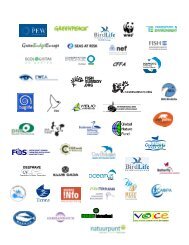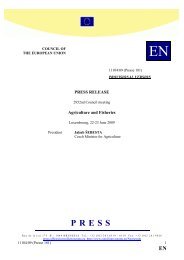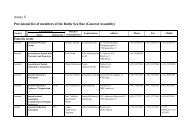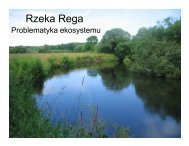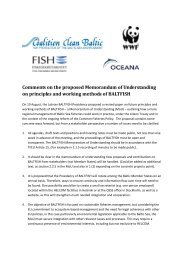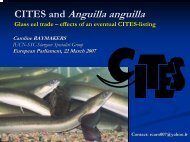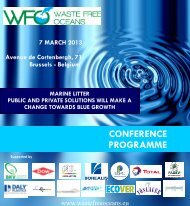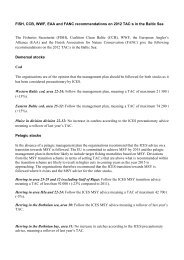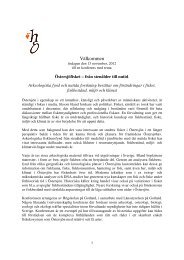A report on iUU fishing of Baltic Sea cod - Fisheries Secretariat
A report on iUU fishing of Baltic Sea cod - Fisheries Secretariat
A report on iUU fishing of Baltic Sea cod - Fisheries Secretariat
Create successful ePaper yourself
Turn your PDF publications into a flip-book with our unique Google optimized e-Paper software.
The coastal fleet target <strong>Baltic</strong> herring, salm<strong>on</strong>,trout, vimba, flounder, eel and pike perch, andalso sprat and <strong>cod</strong> in smaller quantities (ICES,2005)The table below provides an indicati<strong>on</strong> <strong>of</strong> thetotal <str<strong>on</strong>g>report</str<strong>on</strong>g>ed landings in 2003 for the Latvianfleets.Total landings 2003 (t<strong>on</strong>nes)High seas fleet <strong>Baltic</strong> <strong>Sea</strong> fleet Coastal fleet42,376 71,566 3,500The table below shows the <str<strong>on</strong>g>report</str<strong>on</strong>g>ed quantities <strong>of</strong>the main species <strong>of</strong> fish in metric t<strong>on</strong>nes landedby the Latvian fleet.Main species 1995 1996 1997 1998 1999Cod 6,643 8,741 6,187 7,778 6,914Herring 9,300 11,600 10,100 10,000 8,300Sprat 24,400 34,200 49,300 44,900 42,800Main species 2000 2001 2002 2003 2004Cod 6,280 6,298 4,867 4,634 5,027*Herring 6,700 5,200 3,900 3,100 2,700*Sprat 46,200 42,800 47,500 41,700 52,400*PreliminarySource: ICES, 2005The processing sectorThe fish processing sector is almost entirelysustained by the nati<strong>on</strong>s fleets. There are morethan 100 fish processing enterprises in Latvia,most <strong>of</strong> whom are located <strong>on</strong> the <strong>Baltic</strong> <strong>Sea</strong> andGulf <strong>of</strong> Riga coasts, close to the <strong>fishing</strong> ports inthe districts <strong>of</strong> Riga, Tukums, Talsi, Liepaja andLimbazi (FAO, 2005b).<strong>Baltic</strong> herring and sprat are the main raw material.Mackerel and Atlantic herring and theirfillets are also being used for processing. Cannedproducts have decreased more recently, beingreplaced by chilled and frozen fish products.This means that export volumes have a greaterproporti<strong>on</strong> <strong>of</strong> low-added-value products, and ac<strong>on</strong>siderable part <strong>of</strong> locally available fish resourcesis being exported (FAO, 2005b).LITHUANIAKlaipeida is Lithuania’s main seaport. The c<strong>on</strong>tributi<strong>on</strong>made by fisheries to GDP is estimated tobe 0.08%, but is more important in coastal areas(FAO, 2005b). In the past few years, the averageyearly yield has been 10,000–15,000 t<strong>on</strong>nes <strong>of</strong>various species, 2–3 % <strong>of</strong> which is caught in thecoastal areas. The main species are <strong>cod</strong>, herring,sprat and flounder. Some foreign vessels, mostlyRussian, land their catches in Klaipëda (FAO,2005b).As many as 2,500 fishermen are <str<strong>on</strong>g>report</str<strong>on</strong>g>ed to beemployed (FAO, 2005c), which appears to be adisproporti<strong>on</strong>ate amount as <strong>of</strong>ficial figures indicate<strong>on</strong>ly 24 distant water vessels and 292 registeredvessels <strong>fishing</strong> in the <strong>Baltic</strong> <strong>Sea</strong> and coastalregi<strong>on</strong>s (FAO, 2005b; Eur<strong>of</strong>ish, 2005; LithuanianMinistry <strong>of</strong> Agriculture, 2005).No. high seas No. <strong>Baltic</strong> <strong>Sea</strong> No. <strong>of</strong> coastalvessels > 24 m > 12 m < 24m vessels < 12 m24 6 01Source: Lithuanian Ministry <strong>of</strong> Agriculture, 2005Pelagic trawling for sprat and herring and demersaland pelagic trawling for <strong>cod</strong> is used al<strong>on</strong>gwith some gill netting and very occasi<strong>on</strong>ally driftnets and l<strong>on</strong>g-lines (FAO, 2005b; ICES, 2005).The Latvian <strong>Baltic</strong> <strong>cod</strong> fleet <strong>on</strong>ly fish in SD 25-32(Eastern <strong>cod</strong> stock). Outside <strong>of</strong> the closed seas<strong>on</strong><strong>cod</strong> is fished all year round and, in some years,as much as <strong>on</strong>e third <strong>of</strong> the total landings havebeen made in Denmark and Sweden. Herring andsprat are caught all year round, however, there isa marked decrease in effort in the summer. Spratand herring catches are used for human c<strong>on</strong>sumpti<strong>on</strong>.Due to the lower abundance <strong>of</strong> <strong>cod</strong> inrecent years catches <strong>of</strong> flounder have increased(FAO, 2005c; Lithuanian Ministry <strong>of</strong> Agriculture,2005).The table below shows the <str<strong>on</strong>g>report</str<strong>on</strong>g>ed quantities <strong>of</strong>the main species <strong>of</strong> fish in metric t<strong>on</strong>nes landedby the Lithuanian fleet.Main species 1995 1996 1997 1998 1999Cod ,513 5,524 4,601 4,176 4,371Herring 3,600 4,200 3,300 2,400 1,300Sprat ,900 10,200 4,800 4,500 2,300Main species 2000 2001 2002 2003 2004Cod 5,165 3,317 3,317 2,767 2,041*Herring 1,100 1,600 1,500 2,100 1,800*Sprat ,700 3,000 2,800 2,200 1,600*preliminarySource: ICES, 2005– 57 –



